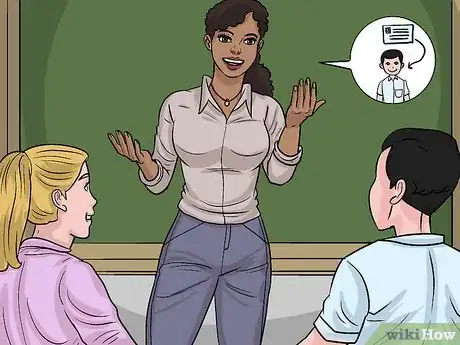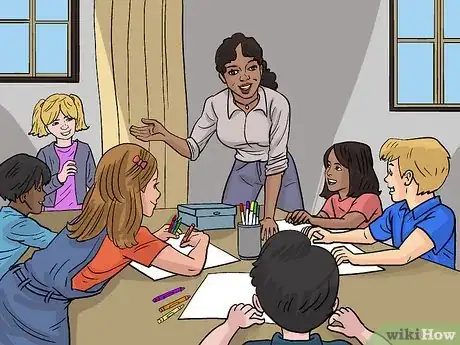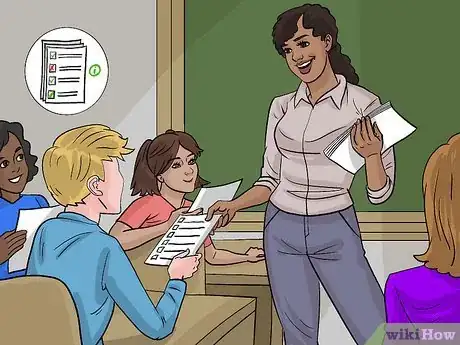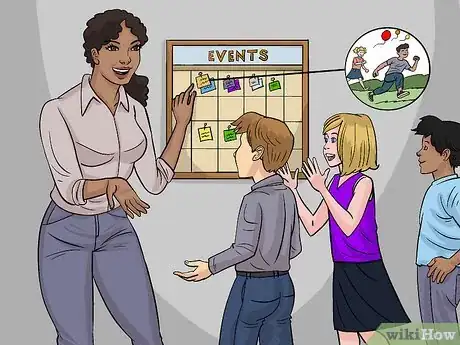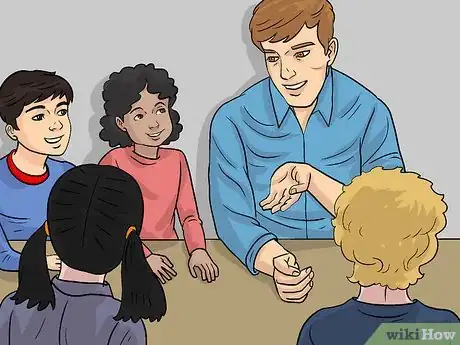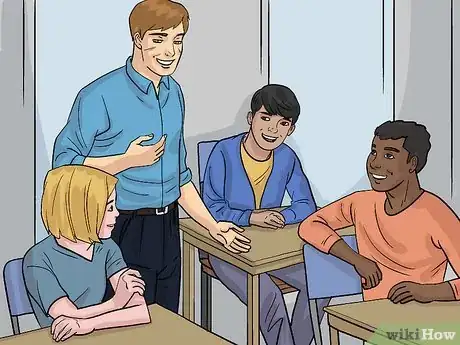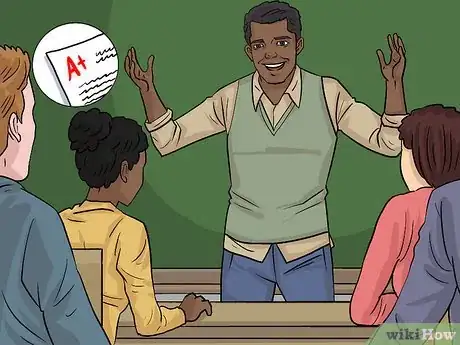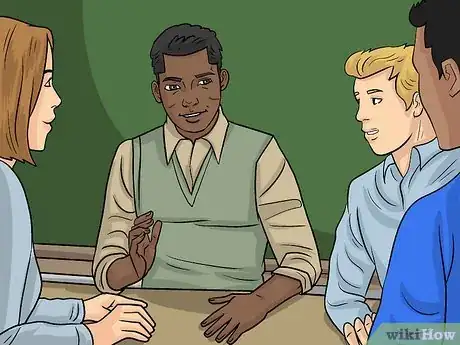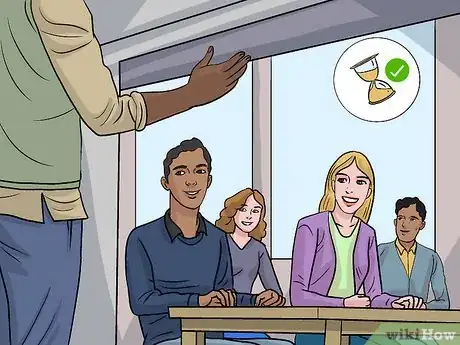This article was co-authored by Soren Rosier, PhD and by wikiHow staff writer, Dan Hickey. Soren Rosier is a PhD candidate at Stanford's Graduate School of Education. He studies how children teach each other and how to train effective peer teachers. Before beginning his PhD, he was a middle school teacher in Oakland, California, and a researcher at SRI International. He received his undergraduate degree from Harvard University in 2010.
There are 9 references cited in this article, which can be found at the bottom of the page.
This article has been viewed 37,087 times.
A strong student-teacher relationship is critical to keeping students engaged in the learning process. Plus, it feels good to have your students like you! Taking the time to get to know all your students as individuals in a positive learning environment is key to developing this bond and winning your students’ affection, regardless of their age. Keep reading for a list of simple but effective ways to learn more about your students and become the likable teacher they’ll talk about for years.
Steps
Learn and use your students’ names.
-
Using a person’s name shows you respect and recognize them. Saying a student’s name shows you have a genuine interest in speaking to them, and they are more likely to engage in conversation and start to trust you. Greet students by name as they enter your classroom or as you pass them in the hallway, and aim to use their name at least once during one-on-one conversations.[1] X Research source
- To learn a new group of students’ names quickly, try asking them to fill out name tags on the first day of class. This will also help students get to know each other.
- For younger students, a name game makes a fun icebreaker activity that gets the entire class interacting with each other.
Participate in class activities.
-
Students usually think of teachers as separate from themselves. Join them in whatever experiment, project, or discussion they are doing in your class. When you get involved in the work and show you’re passionate about it, you’ll form a reciprocal relationship with your students and earn their respect.[2] X Trustworthy Source Understood Nonprofit organization dedicated to resources and support to people with thinking differences, such as ADHD or dyslexia Go to source
- Joining in a group activity as a teacher is a great way to help younger students see the activity as fun instead of a required task. The more fun they have with you, the stronger their affection for you will be.
- For older students where in-class activities are less common, integrate yourself into class discussions and have thoughtful exchanges with students rather than simply asking questions and selecting participants to answer them.
Pass out an Interest Survey.
-
Take an inventory of your students’ hobbies, interests, and favorites. A questionnaire or a survey is an easy way to collect this information and show that you’re genuinely interested in your students’ lives outside of the classroom. Use what you learn about them to strike up friendly conversations during downtime and demonstrate that you care about the information they give you.[3] X Trustworthy Source National Education Association Union of professional teachers devoted to promoting the success of the public education system by advocating on behalf of teachers and students. Go to source
- Try incorporating popular answers into your lesson plans. For example, if multiple students say they like watching The Great British Bake Off, try using baking recipes to create math problems involving fractions.
- Young students who are still learning how to read and write can prepare a short presentation about themselves and their favorite things as a fun alternative to a written survey.
Picture your students outside of the classroom.
-
Your students have a whole life outside of your class. Find out what their schedules are like, what they do for fun, or what major events or milestones they have coming up. This information will help you understand how they act in class and give you things to relate to them through besides the course material.[4] X Trustworthy Source National Education Association Union of professional teachers devoted to promoting the success of the public education system by advocating on behalf of teachers and students. Go to source
- One fun idea to get to know more about your students’ lives is to create a community events calendar in your classroom. Students can add birthdays, sports games, community theater plays, or other activities they’re involved in. If it’s appropriate, you can attend one of their events to show you’re supportive of them and not just their math grades. If you can’t go, it’ll still give you ample conversation starters.
Help students bond with each other.
-
Build a positive classroom community among all your students. When students get along and enjoy each other’s company, they’ll associate you and your class with fun and friendship. Community-building activities like sharing circles, class games, and group projects are all ways to help your class function as a social unit.[5] X Trustworthy Source American Psychological Association Leading scientific and professional organization of licensed psychologists Go to source
- Noticing which students are friendly with each other can help you form a relationship with distant students. Try striking up a conversation about a topic of interest to a shy student with a friend of theirs. If they overhear the conversation, they might be drawn in and open up to you a bit more. This is particularly helpful for elementary and some junior high students.[6] X Trustworthy Source Association for Supervision and Curriculum Development Nonprofit organization providing innovative, effective educational resources for educators designed to support student achievement Go to source
Seek one-on-one time with students.
-
Make an effort to spend time individually with each student. These can be brief exchanges in the hallway between classes or as everyone is packing up their books at the end of the school day. This gives you the opportunity to get to know them more personally and will help create a more positive relationship with them. This is especially effective for students who are difficult or shy.[7] X Trustworthy Source American Psychological Association Leading scientific and professional organization of licensed psychologists Go to source
- Try speaking one-on-one with challenging elementary students every day, even if it’s only for 30 seconds. The consistency will show them you’re trying to get to know them, and will eventually help break down barriers and improve your relationship.[8] X Trustworthy Source Association for Supervision and Curriculum Development Nonprofit organization providing innovative, effective educational resources for educators designed to support student achievement Go to source
- For junior high and high school students, try a “check-in day” where you meet one-on-one with each student briefly while the rest of the class works on an assignment. The meeting can start with observations about class and transition to more personal topics if appropriate.
- Even if a student appears unresponsive to your attempts to talk, they hear what you’re saying. They may not open up immediately, but their relationship with you might blossom in the long term.[9] X Trustworthy Source American Psychological Association Leading scientific and professional organization of licensed psychologists Go to source
Listen to your students’ thoughts and opinions.
-
Your students are individuals with unique perspectives and ideas. When students feel free to communicate their thoughts and feelings with you, they’re more likely to stay engaged in the learning process and to come to you for encouragement and support when needed. Two-way communication contributes to an inclusive and respectful classroom climate.[10] X Research source
- Engage in dialogue with students instead of simply talking “at” them. Give them a chance to let you know how they feel or what they think.[11] X Trustworthy Source National Education Association Union of professional teachers devoted to promoting the success of the public education system by advocating on behalf of teachers and students. Go to source
- For younger students, look at nonverbal clues like body language and eye contact to help gauge their feelings since they might not be able to verbally articulate all of their thoughts yet.
- Anonymous student satisfaction surveys can be a useful tool for gathering feedback from older students who may not be comfortable verbally sharing their feedback on their classroom experience.
Respond to students with empathy.
-
Validate the feelings of your students. Actively listen to their problems or complaints and set aside your own reaction, even if you think their feelings are unjustified or unreasonable. Students of all ages will become closer to you because they feel heard and appreciate your empathy.[12] X Trustworthy Source Understood Nonprofit organization dedicated to resources and support to people with thinking differences, such as ADHD or dyslexia Go to source Learn more about their feelings by asking open-ended questions tailored to their age like:
- “Can you tell me more about what happened at recess today, Mikey?”
- “Hey Carmen, did something happen in the cafeteria today that bothered you?”
- “Tara, is there something new going on that’s preventing you from turning in your assignments on time?”
Be relaxed in the classroom.
-
You are the primary role model for class behaviors and feelings. If you’re tense or irritable, your students will be too. Demonstrate an even temper and a calm, open demeanor to keep communication open and continue building on positive relationships. An angry outburst can set back the progress you’ve made with some students.[13] X Trustworthy Source American Psychological Association Leading scientific and professional organization of licensed psychologists Go to source
- Model how to deal with negative emotions. If your students observe you take a deep breath and then calmly address a disruptive incident in class, they’ll start to copy what you do in similar situations.
Be consistent.
-
Students are most comfortable when they know what to expect. Model positive interactions from day one to promote a healthy social experience in your classroom. Be inquisitive and use a friendly and polite tone to set the standard for the school year. The consistency will help students of all ages stay engaged in the learning process and feel more at ease around you.[14] X Trustworthy Source American Psychological Association Leading scientific and professional organization of licensed psychologists Go to source
- Stay consistent with your discipline and grading policies as well. Post your rules and expectations in your classroom for elementary students, or give each high school student a handout so that everyone is on the same page from day one. This will help prevent arguments over grades or discipline later. If changes need to be made, make sure the entire class is aware.[15] X Research source Soren Rosier, PhD. PhD in Education Candidate, Stanford University. Expert Interview. 1 May 2019.
Keep your standards high.
-
High expectations mean you believe your students can succeed. Turning a blind eye towards disruptive behavior or diluting the course material to make it easier will make your students feel like you don’t expect them to achieve or learn. If you believe in them, they’ll like you![16] X Research source Give meaningful feedback and highlight their accomplishments to show you’re genuinely interested in helping them learn while pointing out things they can improve on.[17] X Trustworthy Source American Psychological Association Leading scientific and professional organization of licensed psychologists Go to source Try phrases like:
- “I like how you’ve been using your inside voice in class lately when you’re feeling upset, Alicia. Sometimes I hear your outside voice in the hallway before class. Can you use your inside voice in the hallway too?”
- “You’ve made great progress on your essay writing this semester, Rico! Let’s take another look at your conclusion paragraph and see if we can make it as good as the rest of your paper.”
- “Kevin, your independent work is always very strong. I’d love to see you put the same energy into your group work this semester as well.”
Be sincere and open.
-
Students can detect if you’re being ingenuine right away. Be honest about why you want to have a good relationship. Explain how it contributes to better learning, or tell them that you want to make the school year more fun for everyone. If students believe you’re really there for them, they’ll be more receptive to your efforts and begin to trust you more.[18] X Research source
- Make sure your actions match your words. If you talk a big game about wanting to know your students but then yawn or act disinterested when they talk to you, they won’t believe you really care about them.[19] X Trustworthy Source American Psychological Association Leading scientific and professional organization of licensed psychologists Go to source
- Explain your motivation for getting to know your students by making a class announcement like, “We’ll have fun and learn more together if we get to know each other! That’s why I want to know a little bit more about you.”
- If you’re trying to reach an individual student, try an empathetic like, “The school year can seem long and difficult, and I’m here to support you as a person as well as teach you history.”
Remember that good relationships take a long time to form.
-
Some students will need time to warm up to you while others will be friendly right away. Time and consistency are the key ingredients in forming positive relationships with your students. You’ll see the fruits of your labor after several weeks or even months. Remember that all students, even the difficult ones, will benefit from your efforts to develop a good relationship, but not all students will show it at the same time.[20] X Trustworthy Source American Psychological Association Leading scientific and professional organization of licensed psychologists Go to source
You Might Also Like
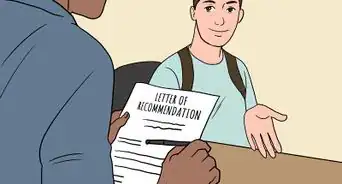



 14 Effective Ways to Meet the Individual Needs of Students
14 Effective Ways to Meet the Individual Needs of Students
 How to Teach Good Handwriting
How to Teach Good Handwriting


-Step-15.webp)





References
- ↑ https://www.canr.msu.edu/news/using_a_persons_name_in_conversation
- ↑ https://www.understood.org/articles/en/teacher-to-teacher-use-a-daily-warm-up-to-build-empathy?_sp=8509a973-51e9-4f03-9d54-5d9788e5a9ef.1640287977503
- ↑ https://www.nea.org/professional-excellence/student-engagement/tools-tips/creating-caring-connections-classroom
- ↑ https://www.nea.org/professional-excellence/student-engagement/tools-tips/creating-caring-connections-classroom
- ↑ https://www.apa.org/education-career/k12/relationships
- ↑ https://www.ascd.org/el/articles/the-two-minute-relationship-builder
- ↑ https://www.apa.org/education-career/k12/relationships
- ↑ https://www.ascd.org/el/articles/the-two-minute-relationship-builder
- ↑ https://www.apa.org/education-career/k12/relationships
- ↑ https://schools.au.reachout.com/articles/why-its-important-to-understand-student-needs-and-interests
- ↑ https://www.nea.org/professional-excellence/student-engagement/tools-tips/creating-caring-connections-classroom
- ↑ https://www.understood.org/articles/en/7-ways-to-respond-to-students-with-empathy
- ↑ https://www.apa.org/education-career/k12/relationships
- ↑ https://www.apa.org/education-career/k12/relationships
- ↑ Soren Rosier, PhD. PhD in Education Candidate, Stanford University. Expert Interview. 1 May 2019.
- ↑ https://www.learningandthebrain.com/blog/students-like-you/
- ↑ https://www.apa.org/education-career/k12/relationships
- ↑ https://www.learningandthebrain.com/blog/students-like-you/
- ↑ https://www.apa.org/education-career/k12/relationships
- ↑ https://www.apa.org/education-career/k12/relationships
About This Article

